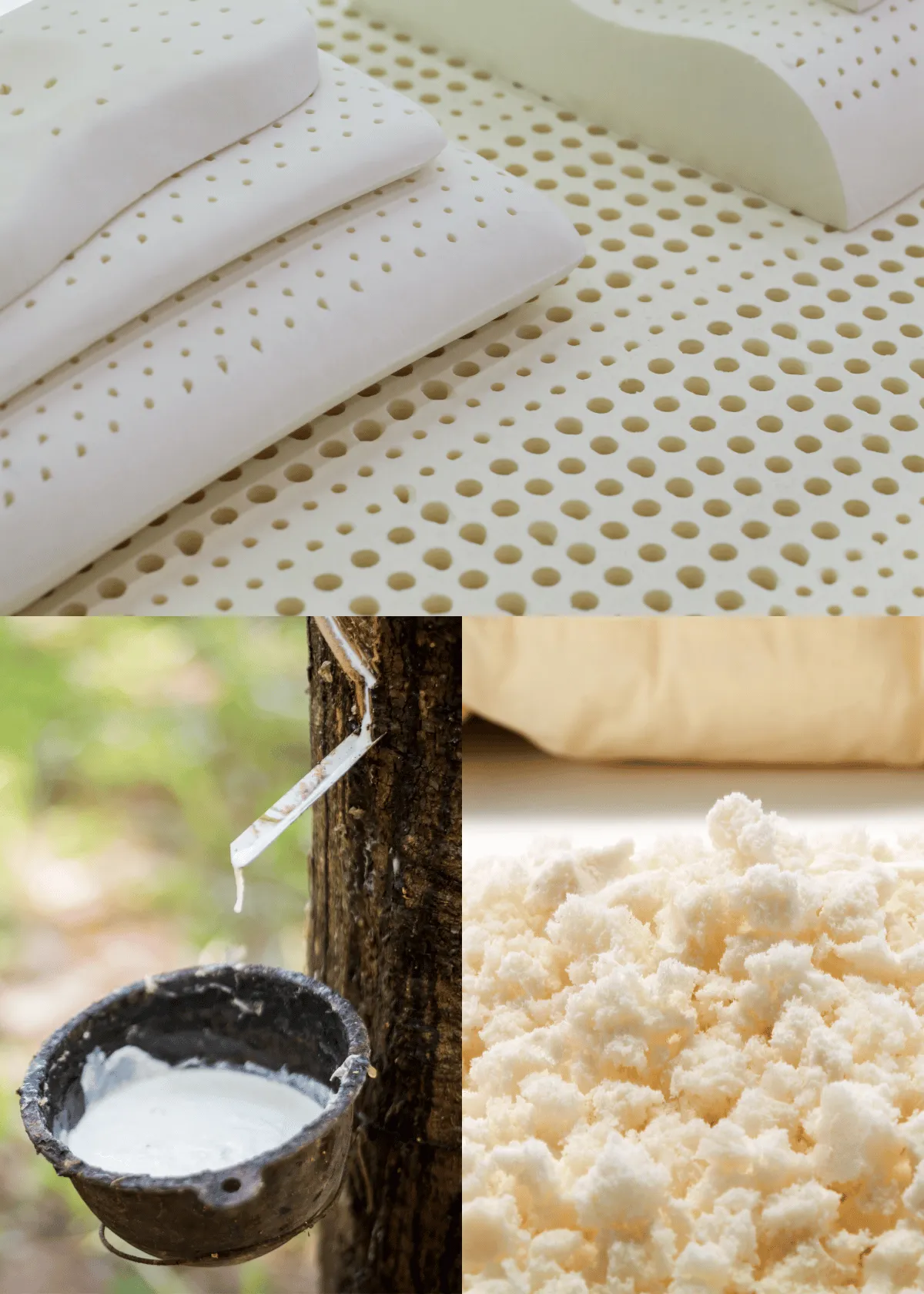(Last Update: 05/07/2024)
KEY TAKEAWAYS:
- Latex mattresses have distinct advantages and disadvantages and are a popular "green" alternative to memory foam, created through Dunlop or Talalay processes.
- When choosing the right latex bed, consider firmness, density, and certifications like GOLS and GOTS.
- Memory foam is an excellent option for those with allergies because it lacks the proteins found in natural rubber latex.
Understanding Latex Foam

A 3D Material of Natural Latex For Mattress
(Credit: Canva)
Before diving into the specifics of both Dunlop and Talalay latex beds, let's first understand the basics of latex foam. Latex foam is sourced from rubber tree sap and comes in natural and synthetic latex forms.
Natural latex foam is derived from the milky substance extracted from the hevea-Brasiliense rubber tree, while synthetic latex form foam is made from chemical compounds like styrene and butadiene.
Due to its durability, cooling properties, and exceptional pressure relief, latex foam has become a popular "green" alternative to memory foam mattresses.

An Open Spring and Foam Bonnell Mattress
(Credit: Canva)
Rubber tappers make precise cuts under the bark of living rubber trees to harvest the latex. A tap and collection bowl are inserted beneath the cut to capture the flowing liquid.
How does the raw material work? The raw latex is then mixed with water and other ingredients, such as gelling, foaming, and vulcanizing agents, to convert the liquid latex extract into a solid.
Dunlop latex production means solidifying Dunlop latex, which is then poured into a mold. This marks the start of the difference between natural Dunlop and Talalay latex.
The Creation of the Latex Mattress

A Sample of Rubber Material
(Credit: Canva)
The making of natural foam latex starts with the same initial process for both Talalay and Dunlop latex types. The sap is extracted from rubber trees as raw material, and the liquid latex is mixed with water and other agents to create a solid foam. However, the differences between the two types of natural latex mattresses arise during the molding process.
The Dunlop method is simple. Dunlop latex natural is created by pouring the entire latex mixture into a mold in one complete pour, which pushes carbon dioxide, which causes the latex to settle, resulting in a denser bottom and softer top.
Talalay latex production, on the other hand, involves a more energy-intensive process. As a result, the mold is only partially filled with pure latex serum, and carbon dioxide expands the foam, making it lighter and more breathable.
Latex foam is first whipped into a frothy liquid in the Talalay process. This latex foam is then poured into molds, which are vacuum-expanded and flash-frozen. Subsequently, the latex foam is baked, solidifying into the final latex foam product, known for its uniformity and comfort in mattresses.
Now that we have a basic understanding of the creation process let's delve deeper into the process and features of Dunlop and Talalay latex.

The Joy of Bedding of a Sunrising Bedding Natural Latex Mattress.
(Credit: Sunrising)
Vulcanization process in making the Latex material
Vulcanization is critical in making latex material in the Dunlop and Talalay methods. During vulcanization, the liquid latex mixture is exposed to high temperatures in a vulcanization oven, causing the rubber particles to cross-link and form a durable, elastic material.
The Dunlop process is the most energy-efficient method, and it happens right after the latex is poured into a mold.
In contrast, the Talalay process includes an additional step of flash freezing the latex before it's heated in the vulcanization oven, creating a more consistent cell structure throughout the product.
Dunlop Latex: Process and Features

A LUCID 2-Inch Dunlop Latex Topper In Full Display
(Credit: LUCID)
Developed in 1929, Dunlop latex is made from natural rubber tree material. The Dunlop latex foam mattress manufacturing process involves pouring the liquid latex mixture into a mold in one complete pour. As the liquid sap mixture settles, Dunlop becomes denser at the bottom and softer on the top.
This Dunlop latex foam manufacturing process results in a few advantages and disadvantages of Dunlop latex bed, which we will explore in the following subsections.

Sample of Latex Filling for Mattresses and Pillows
(Credit: Canva)
Advantages of Dunlop Latex
One of Dunlop latex foam's primary advantages is its density and firmness. As a result, it provides enhanced support and durability, making it ideal for those who prefer a firmer sleeping surface.
This density results from the single-pour manufacturing Dunlop process, creating a more solid and supportive foam than the two-pour process used for latex.
Additionally, Dunlop latex is more sustainable and energy-efficient than Talalay latex. The Dunlop latex manufacturing process requires less energy, making it a more environmentally friendly choice and durable latex for those who prioritize green living.
Now, let's examine some of the drawbacks of Dunlop latex.

A Beautiful Display of a Happsy Organic Latex Mattress
(Credit: Happsy)
Disadvantages of Dunlop Latex
Despite its advantages, Dunlop latex does have some drawbacks. The primary disadvantage is its elevated price point, which tends to be more costly than Talalay. Another issue is the increased weight of Dunlop latex, which can make it more challenging to move or adjust.
Furthermore, some individuals may experience a latex allergy, which can cause discomfort or health risks. However, it's important to note that Dunlop latex is generally considered a safe and healthy material to sleep on, and the advantages of sleeping organic often outweigh the disadvantages for many consumers.
Next, let's explore the process and features of Talalay.
Talalay Latex: Process and Features

A Rubber Tree With a Sample of Rubber
(Credit: Canva)
Talalay latex undergoes a more complex and energy-intensive process than Dunlop latex. The liquid latex is whipped into a foam mix, poured into a partially filled mold, vacuum sealed, flash-frozen with carbon dioxide gas, baked, cleaned, dried, and packaged. This process produces a lighter, more breathable foam than Dunlop foam latex.
Like Dunlop latex, Talalay latex has its advantages and disadvantages, which we will discuss in the following subsections.

Turmerry Latex Mattress Topper
(Credit: Turmerry)
Advantages of Talalay Latex
One of the most notable advantages of Talalay is its breathability. The flash-freezing step during manufacturing the Talalay process and using carbon dioxide create air pockets within the foam, allowing for better air circulation and temperature regulation. This makes Talalay latex an excellent choice for body heat retention and for those who tend to sleep hot.
Talalay is springiness and responsiveness. It conforms well to the contours of the human body, providing remarkable pressure point relief and natural spinal alignment. However, Talalay has drawbacks.
Disadvantages of Talalay Latex
The primary drawback of Talalay latex is its higher price point than Dunlop latex. This is due to the more complex and energy-intensive latex production, the Talalay process itself, which requires four times the duration and five times the energy of the Dunlop latex option.
Additionally, Talalay may have a shorter lifespan than its Dunlop counterpart, as it is less dense and more susceptible to wear and tear.

The Turmerry Latex Mattress Topper
(Credit: Turmerry)
Dunlop vs. Talalay Latex
Considering your preferences and needs would be best when comparing Dunlop vs. Talalay latex mattresses. The Dunlop latex foam mattress is denser and firmer, providing enhanced support core and durability.
On the other hand, Talalay latex is softer and less dense, offering increased breathability and temperature regulation. Dunlop vs. Talalay latex beds have unique advantages and disadvantages; the choice ultimately comes down to personal preference.
When choosing between Dunlop vs. Talalay latex beds, factors such as price, cooling properties, firmness level, and edge support should be considered.
It's also worth noting that the overall quality and reputation of the manufacturer are typically more important than the specific type of latex used in the Dunlop mattress.
How to Choose the Right Natural Latex Mattress

Latex Rubber For Pillow and Mattress
(Credit: Canva)
Firmness, thickness, and density must be considered when selecting a latex bed. A medium-firm mattress is generally recommended, as it provides the right balance of support and comfort.
The mattress's thickness should also be appropriate for your body weight, and its density should be soft and firm enough.
It's also important to research online reviews and ratings to evaluate a mattress's reputation. Please ensure that reviews come from verified customers and read through the comments to better understand the mattress's quality.
Also, please remember certifications such as the Global Organic Latex Standard (GOLS) and the Global Organic Textile Standard (GOTS). These certifications can provide reassurance that the mattress you're considering is made with high-quality, eco-friendly materials.
Latex Allergies and Alternatives

Organic Latex Mattress Sample
(Credit: Canva)
While latex beds offer numerous benefits, being aware of potential latex allergies is essential.
Direct contact between skin and latex can induce an allergic reaction, ranging from skin irritation to anaphylaxis. If you have a latex allergy, choosing a different mattress material is crucial.
Memory foam is a suitable alternative for those with latex allergies. Memory foam mattresses are made from polyurethane foam, a synthetic material that does not contain the proteins found in natural rubber that create latex foam.
Like a latex bed, a foam mattress offers excellent relief of pressure points, support core, and motion isolation, making it a popular choice for many sleepers.
Certifications for Organic Latex Mattresses

Latex Rubber For Pillows and Mattresses
(Credit: Canva)
When shopping for an organic latex bed, it's essential to look for certifications like the Global Organic Latex Standard (GOLS). GOLS certification ensures that the latex used in the mattress meets strict requirements for farming, processing, manufacturing, packaging, and shipping.
In addition, this certification helps guarantee that your natural latex bed is made from high-quality, eco-friendly materials.
Another certification to look for is the Global Organic Textile Standard (GOTS). GOTS certifies organic fibers like cotton and wool, ensuring your mattress cover is made from natural, non-toxic materials.
By choosing a mattress with these certifications, you can rest easy knowing you're making a responsible and sustainable purchase.
Latex vs. Memory Foam

White Nature Latex Rubber For Pillow and Mattress
(Credit: Canva)
Latex and memory foam are different materials with unique properties and advantages. Latex is made from the sap of a rubber tree and is a natural material, while memory foam is synthetically produced from petroleum products.
As a result, latex is more breathable and environmentally friendly than memory foam, but memory foam offers superior edge support, pressure relief, and motion isolation.
When deciding between latex and memory foam, you must consider your personal preferences, needs, and any allergies you may have.
In addition, both materials have unique advantages and disadvantages, so it's crucial to weigh these factors carefully before deciding.

Natural Latex Rubber Put-in Pillows and Mattresses
(Credit: Canva)
Summary
In conclusion, you'll need to consider your preferences and needs when choosing between Dunlop and Talalay beds. How does the Talalay latex differ from the Dunlop latex?
Both types of latex offer unique advantages and disadvantages, so it's crucial to weigh these factors carefully before making your decision.
Remember that the overall quality and reputation of the manufacturer are typically more important than the specific type of latex used in the mattress.
By considering factors such as firmness, thickness, density, and certifications, you can make an informed decision and find the perfect latex bed for a comfortable and restful night's sleep.
Sweet dreams!

Hybrid Foam Latex Bonnell Spring Mattress
(Credit: Canva)
Frequently Asked Questions
Is Talalay latex cooler than Dunlop?
Talalay latex is generally cooler than Dunlop latex layers due to its improved breathability. Talalay also offers a more varied range of firmnesses than the Dunlop option for sleepers looking for a personalized feel in their mattress. Jun 19, 2023.
Which is better, Dunlop or Talalay latex pillows?
Temperature neutrality Talalay latex pillows are the better option since they provide a more breathable, temperature-neutral surface.
Additionally, they are often softer and available in various densities. Or these reasons, pillows made with Talalay are the better choice.

A Young Lay resting on a Pure Green Organic Latex Firm Mattress
(Credit: Latex For Less )
Why is Talalay more expensive?
Talalay foam is more expensive because it undergoes an extensive manufacturing process, which includes pouring the foam into a mold, vacuum sealing it, and flash-freezing it.
This extra effort results in a denser mattress and a more uniform consistency than Dunlop latex beds, making the Talalay mattress worth the price.
What is liquid latex when comparing Talalay and Dunlop latex?
The liquid latex used in Dunlop and Talalay is the same, but the manufacturing process creates different feels. Liquid latex is the base material for both Talalay and Dunlop.
However, the manufacturing process is different for each type of latex. Dunlop is created by pouring the liquid latex into a mold and then vulcanizing it.
In contrast, The Talalay is created by pouring the liquid into a mold, vacuum-sealing it, and then vulcanizing it.

Natural Latex Rubber in Pillows
(Credit: Canva)
What are the best benefits of a Latex mattress topper?
A latex mattress topper provides excellent support core, relieving pressure points and back pain. It's naturally hypoallergenic, highly durable, and resistant to dust mites and mold. Moreover, it improves breathability and maintains a comfortable sleep temperature.
What are the benefits of Talalay latex?
An organic latex bedding product beds offers excellent pressure relief and support, as the top layer of wool cushions the sleeper's body and the underlying Talalay latex contours to the sleeper.
Additionally, this type of responsive latex bed is breathable, exceptionally durable, temperature neutral, and helps promote proper spine alignment for a more restful sleep.







